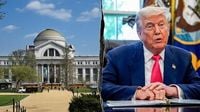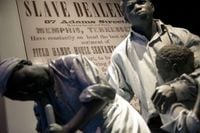As the United States approaches its 250th anniversary, a fierce battle over the nation’s historical memory is unfolding at the heart of its most cherished cultural institution. The Smithsonian Institution, home to 17 museums and countless artifacts chronicling the American story, is facing unprecedented federal intervention under President Donald Trump’s administration. The result is a storm of controversy, fear, and debate over who controls the narrative of America’s past—and what’s left out.
In March 2025, President Trump issued an executive order, pointedly titled “Restoring Truth and Sanity to American History.” This sweeping directive placed Vice President J.D. Vance in charge of reviewing Smithsonian exhibitions, with a stated goal of removing “divisive” narratives—especially those addressing race, slavery, and systemic injustice. According to ABC News, the order’s effects were soon felt: by August 1, 2025, references to Trump’s own two impeachments had been quietly scrubbed from the National Museum of American History’s “Limits of Presidential Power” exhibit. The official explanation was a return to a 2008 version of the display, but internal sources and public reporting pointed to direct White House pressure.
Trump’s impeachments—first in 2019 for abuse of power and obstruction of Congress, then in 2021 for incitement of insurrection—made him the only U.S. president impeached twice. Yet, for a time, these historic events vanished from the museum’s public record. After a wave of criticism, the references were eventually restored, but the incident left staff and visitors shaken. “People are angry,” one Smithsonian worker told HuffPost. “And sad.”
The administration’s focus has gone further, targeting the National Museum of African American History and Culture in particular. In April, Pulitzer Prize-winning journalist Nikole Hannah-Jones told Black Press USA that these efforts were “a sign of a deep sickness.” She warned, “To erase or minimize the slavery and freedom part of that story is to create a fantasy of how we got here. We literally would not be in the United States without slavery.”
That same month, civil rights leader Dr. Amos C. Brown revealed on the Let It Be Known show that the museum had abruptly returned historic artifacts he had loaned—including a civil rights-era Bible and one of the earliest histories of Black Americans—without discussion. “This is a direct result of Project 2025,” Brown said. “There is a move in this country to induce cultural and historical Alzheimer’s.”
Smithsonian Secretary Lonnie Bunch, who has led the institution since 2019, has publicly pledged to “remain committed to telling the multi-faceted stories of this country’s extraordinary heritage” despite mounting pressure. But the White House’s August 12 letter to Bunch demanded access to internal curatorial documents, exhibition plans, and educational materials from eight major museums. The administration insisted on “content corrections” to replace what it called “ideologically driven” narratives with those celebrating “American exceptionalism.” According to HuffPost, Russ Vought, director of the Office of Management and Budget, made clear that compliance was not optional: if the Smithsonian did not align with the President’s directive, its federal funding—about two-thirds of its annual revenue—was at risk.
The threat has sent shockwaves through the Smithsonian’s workforce. Staff describe an atmosphere of fear and self-censorship. “Everyone is so scared,” said one longtime worker, speaking anonymously to protect their job. “It’s an impossible position to put us in. We can’t be political with our content, but they have politicized everything. We need to prove we’re not partisan by following this very partisan directive. What are we supposed to do? It’s like up is down. It’s maddening.”
Leadership has reportedly instructed employees to avoid putting substantive communications in writing, fearing repercussions. Work plans are now shared verbally, while email is reserved for benign, institution-wide messages. Volunteers, too, are disillusioned and some are considering leaving. “Many of them are furious,” said one volunteer. “All that I’ve met that volunteer there really love the Smithsonian and believe that [Trump] aims to destroy it.”
The impact has already reached exhibitions and programming. The National Portrait Gallery lost a show by an artist who refused to remove a painting of a transgender woman. At the National Museum of American History, the temporary erasure of Trump’s impeachments from a display about impeached presidents sparked public outcry. Meanwhile, the National Museum of African American History and Culture came under fire for returning civil rights artifacts to their owners without being asked.
President Trump has defended his actions, stating on August 14, 2025, “We want the museums to treat our country fairly. We want the museums to talk about the history of our country in a fair manner, not in a woke manner, or in a racist manner, which is what many of them, not all of them, but many of them are doing.”
But critics say the administration’s moves echo authoritarian tactics seen in countries like North Korea, China, Saudi Arabia, and Cuba—nations ranked among the world’s most censored by the Committee to Protect Journalists. “Censoring the arts is a move straight out of the authoritarian playbook,” Dr. Karrie Koesel, a political scientist at the University of Notre Dame, told HuffPost. She added, “Museums should be places of learning and exchange, not the preferences of the White House.”
Activists and historians warn that this kind of censorship is not new in America. A recent New York Times op-ed drew parallels to West Virginia’s labor history, specifically the Battle of Blair Mountain in 1921, when union miners fought coal operators and lawmen. For over 50 years, state officials suppressed mention of this conflict in textbooks, shaping generations of public understanding. Mary Harris “Mother” Jones once described the suffocating control coal companies held over miners, including their education and access to information. The result, as history shows, was a legacy of tragedy: deadly mine disasters, economic stagnation, and a foster care crisis, all fueled by a lack of honest reckoning with the past.
Senator Raphael Warnock (D-Ga.) summed up the stakes on social media: “They’re trying to erase history before our very eyes.” Savannah Romero, co-founder of the Black Liberation-Indigenous Sovereignty Collective, argued that the focus on museums addressing slavery, colonialism, and the experiences of marginalized groups “makes the intent crystal clear: target the institutions that are bringing to light the true colonial and violent history of the United States.” As she put it, “Control what a society remembers, and you control what it can become.”
For now, the Smithsonian’s leadership maintains, “The Smithsonian’s work is grounded in a deep commitment to scholarly excellence, rigorous research, and accurate, factual presentation of history, and we are proud of our hardworking staff who work to carry out that mission every day.” But as the nation’s 250th birthday approaches, the question remains: whose America will be remembered—and whose stories will be left untold?



